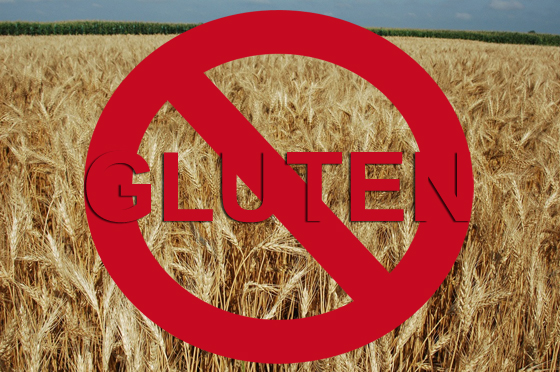Celiac Disease -- you've probably heard of it and know it has something to do with wheat but aren't quite sure what. You might even know that it's related to a gluten-free diet. But given that over two million people in the U.S. have it, becoming acquainted with the disease is a good idea -- especially if you plan on hosting a dinner party any time soon. Here are six facts to help you understand what it is and why it's such a big deal.

The following list about celiac disease has been edited from information and follow-up emails with guests related to KQED Forum's Dec. 7 episode which focused on the rise of the gluten-free diet.
- Celiac Disease is An Autoimmune Disease
While some dismiss celiac as an allergy or "the disease du jour" it is actually "a complex autoimmune and inflammatory disease of the small intestine," said Dr. Nielson Fernandez-Becker, associate director of the Celiac Management Clinic at the Stanford School of Medicine. It is "triggered by the protein gluten which is found in wheat, rye and barley. Basically, repeated ingestion of gluten causes injury to the small intestine," said Fernandez-Becker.Usually the immune system can differentiate between something that's harmful to the body and something that's harmless or even beneficial to it. In the case of celiac disease, gluten, "an otherwise harmless protein is now recognized as a potential pathogen," said Fernandez-Becker. The body reacts accordingly, initiating an immune response to fight-off the perceived threat.
It is possible for someone without celiac disease to suffer from gluten sensitivity -- these people may find relief in a gluten-free diet but, "there is no widely agreed upon definition of non-celiac gluten sensitivity," says Fernandez-Becker. She adds that while it is possible that some forms of gluten sensitivity are part of the celiac disease spectrum, the jury is still out: "more research needs to be done in this area."
- Celiac Disease Can Hit at Any Time
"You can develop celiac disease pretty much at any time," said Fernandez-Becker, "in infancy and in adulthood."While doctors know that there is a genetic predisposition for celiac disease, they don't know what triggers its onset.
Identifying the inciting event "is a subject of intense research right now," says Fernandez-Becker. "Anecdotally, we see patients after they've had a very severe gastroenteritis or a bacterial infection or even pregnancy, later go on to develop celiac disease."
So while you may be tempted to write-off friends who say they have celiac disease as merely being trendy, it's completely feasible for someone to develop the disease well into adulthood.
- Don't Give Up Eating Gluten Before Getting Tested for Celiac
The best thing to do if you suspect that you have celiac is to go to your doctor and ask for the appropriate tests -- before you stop eating gluten."You need to be eating gluten when you go in there," said Dr. Melinda Dennis, dietician and nutrition coordinator with the Celiac Center at Beth Israel Deaconess Medical Center.
"When celiac disease is being considered, it is important to continue consuming gluten because gluten exclusion will treat the disease," said Dr. Fernandez-Becker. "If the patient is not eating gluten there is no way to tell if the antibodies are negative because he or she does not have celiac disease or if it is because they are being treated for celiac disease" by the gluten-free diet.
Testing for celiac is involved. A biopsy is the "gold standard" for diagnosing it. But determining whether one has celiac disease or a gluten-sensitivity is worth the trouble.
"It is important to distinguish because as far as we know, only people with celiac disease develop autoimmunity and are at increased risk for complications such as malabsorption and malignancy," said Fernandez-Becker.
- There is a Link Between Celiac Disease and Osteoporosis
"When you have celiac disease you don't absorb certain vitamins, particularly fat-soluble vitamins such as vitamin D," said Fernandez-Becker. "This adversely affects bone health. One of the things that we recommend is after the patient has been on a stable gluten-free diet for at least six months to a year is to have a baseline bone mineral density[test]. The hope is that as you're on a gluten-free diet, the mucosa heals and your ability to absorb these nutrients is better and hence, the bone health will improve," said Fernandez-Becker. - Celiac Disease Presents Itself Differently in Different People
Symptoms mentioned during the show ranged from digestive issues to migraines to word-dropping and poor concentration. Though cramping, bloating and diarrhea are common symptoms, some people with celiac disease suffer no gastrointestinal symptoms. Dennis was diagnosed with celiac disease after developing Dermatitis herpetiformis, "an itchy blistering skin rash that appears on extensor surfaces like knees and elbows." Celiac.com has a thorough list of symptoms on their website. - The Only Treatment for Celiac is A Gluten-Free Diet
There is no pill or patch that offers a quick fix for celiac disease."Gluten exclusion is the only effective therapy," said Fernandez-Becker.
According to Dennis, a basic list of foods that people need to avoid include: "wheat, rye, barley, malt, brewer's yeast and oats, unless they're specially produced and labeled gluten free" and any products, such as baked goods that contain those grains. There are plenty of hidden glutens in foods, too. "Soy sauce is brewed with wheat. Communion wafers contain wheat," said Dennis.
Even a small amount of gluten can be harmful.
"The FDA will likely soon finalize its definition of gluten-free as under 20 parts per million gluten," says Dennis. And companies that certify foods as gluten-free are certifying products to "under 10 or 5 parts per million. "So while the gluten-free buzz might create extra work for those in the restaurant and food-service industry, it's important to remember that for people with celiac disease, "gluten is a toxic substance."
- Celiac.com
- Celiac Community Foundation of Northern California
- CeliacNow.org
- Gluten-Free Posts (BAB)
INFORMATION AND RESOURCES
If you or someone you are likely to share a meal with soon has celiac disease, there is a growing wave of resources and products for you. Here is a small sampling:
KQED's Forum discusses the rise of gluten-free diets.
Original Broadcast: Fri, Dec 7, 2012 -- 10:00 AM
Listen to the radio program:

